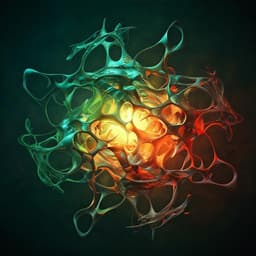
Physics
Direct observation of strong surface reconstruction in partially reduced nickelate films
C. Yang, R. Pons, et al.
This groundbreaking study by Chao Yang and colleagues explores the surface structure of Pr0.8Sr0.2NiO2+x films, revealing intriguing insights into surface polarity and atomic-level phenomena, including the effects of oxygen vacancies from topochemical reduction.
~3 min • Beginner • English
Introduction
Polarity at oxide interfaces and surfaces governs key physical and chemical properties, including ferroelectricity, superconductivity, magnetism, and catalysis. In perovskite nickelates, polar surfaces can induce structural distortions (polar displacements and octahedral rotations) that modify orbital hybridization (Ni 3d–O 2p), affecting metallicity and transport. Despite theoretical predictions of large orbital polarization at NiO2-terminated polar surfaces and interface-driven electronic reconstructions, experimental control and direct atomic-scale characterization of surface polarity remain challenging due to synthesis constraints and probing limitations. Infinite-layer nickelates are synthesized via topochemical reduction, which removes apical oxygen and can profoundly alter surface polarity and Ni valence. This study investigates how controlled oxygen deintercalation modifies surface polarity in Pr0.8Sr0.2NiO2+x films and directly images corresponding atomic/electronic reconstructions using STEM-ABF, 4D-STEM, and STEM-EELS.
Literature Review
Prior work shows that polar interfaces/surfaces in complex oxides produce emergent electronic states (e.g., 2DEG, charge-density waves, localized polarons) and that capping layers or termination control can tune polar distortions and conductivity in LaNiO3. Theoretical studies predict enhanced orbital polarization at NiO2-terminated surfaces due to elongated out-of-plane Ni–O bonds and suppressed hybridization. For infinite-layer nickelates, interface polarity (e.g., NdNiO2/SrTiO3) is predicted to drive charge transfer, but experiments reveal compensating effects from residual oxygen, elemental mixing, and atomic reconstructions. Surface studies are scarce due to synthesis and measurement difficulties; conflicting observations of charge-density waves depending on surface/capping conditions underscore the sensitivity to polarity. Layer-selective topotactic reduction is known to remove apical oxygens more readily than basal ones, potentially creating oxygen-vacancy gradients and altered electrostatics.
Methodology
Film growth and reduction: A pristine Pr0.8Sr0.2NiO3 film was grown on NdGaO3 (110) by ozone-assisted, layer-by-layer molecular beam epitaxy at ~600 °C and 2.4 × 10−7 bar under ozone flow. The 1 × 1 cm2 film was diced into 5 × 5 mm2 pieces; two were reduced topochemically in vacuum-sealed glass tubes using 0.1 g CaH2 at 230 °C for 6 h and 18 h (sample and powder separated by Al foil) to partially deintercalate oxygen and form Pr0.8Sr0.2NiO2+x.
Sample preparation and microscopy: Cross-sectional TEM lamellae were prepared by focused ion beam and cleaned by a NanoMill. STEM imaging (JEOL ARM200F, 200 kV) included HAADF (70–300 mrad) and ABF (10–20 mrad). EELS (Gatan K2 camera, ~1 eV energy resolution at 0.5 eV/channel, collection 85 mrad) was acquired as spectrum images; denoising used PCA. 4D-STEM was performed with a Merlin direct electron detector (256 × 256 pixels) in 1-bit mode at 4.8 × 10−3 s frame time; multiple frames were aligned and summed to improve SNR and minimize scan distortion.
Quantitative image analysis: Atomic positions were determined from HAADF using Gaussian fitting and center-of-mass refinement (Atomap) to extract in-plane/out-of-plane lattice spacings, zigzag A–A–A angles, and B-site (Ni) displacements. ABF resolved oxygen columns to quantify polar distortions and octahedral rotations, and to compute relative Ni–O out-of-plane displacements at NiO2 planes.
Thickness and tilt assessment: Sample thickness (~5.2 nm) and absence of specimen tilt were verified from PACBED patterns and consistent oxygen-octahedra symmetry in ABF.
4D-STEM electric field reconstruction: Atomic electric fields were reconstructed from center-of-mass shifts of diffraction patterns, converting momentum transfer to projected electric field using a simplified quantum mechanical model E⊥ = eΔρ/(Az), where Az is sample thickness. Electric field maps and line profiles were analyzed around atomic columns across the surface-to-bulk.
Simulations: 4D-STEM electric field simulations used supercells derived from ABF-resolved structures of PrNiO3 including surface polar distortions (without explicitly including Sr). Additional simulations substituted O→F and Ni→Cu to test sensitivity to atomic potential changes versus lattice vibrations. Thickness effects (5.2–9.9 nm) on field reconstruction fidelity were explored.
Electronic structure: STEM-EELS analyzed O-K pre-peak (A, B features) to assess Ni 3d–O 2p hybridization and oxygen vacancies, and Ni-L2,3 edges for L3 energy shifts and L3/L2 white-line ratios to infer Ni valence layer-by-layer. Elemental mapping (Ga-L2,3, Nd-M4,5, Pr-M4,5, Ni-L2,3, O-K) provided composition profiles; Sr distribution was assessed by atomic-resolution STEM-EDX due to weak Sr-L2,3 EELS signal. Oxygen content variations were quantified by normalizing integrated O-K to Ni-L2,3 to estimate O/Ni ratios. Density functional theory (supplementary) compared DOS near EF for distorted vs undistorted surfaces and with/without apical oxygen vacancies.
Key Findings
• Pristine Pr0.8Sr0.2NiO3 surface exhibits polar distortion coupled with oxygen octahedral rotations beneath a negatively charged NiO2 termination. The B-site (Ni) surface displacement is ~0.27 Å, decaying to ~0 within ~3 unit cells from the surface.
• Topochemically reduced Pr0.8Sr0.2NiO2+x displays stronger surface polar distortion without detectable octahedral rotation: Ni displacement increases to ~0.37 Å (6 h reduction) and ~0.45 Å (18 h). Relative Ni–O out-of-plane displacement at the NiO2 plane reaches ~0.32 Å (pristine) versus ~0.56 Å (reduced), with polarization decaying over ~3 unit cells in both cases.
• 4D-STEM reveals enhanced atomic electric fields surrounding Ni columns near the reduced film surface relative to the inner layers and substrate; simulations indicate that structural contrast alone does not account for this enhancement, implicating valence/charge redistribution around Ni.
• EELS shows a gradual decrease in the O-K pre-peak A/B intensity ratio approaching the surface, consistent with reduced Ni 3d–O 2p hybridization and/or oxygen vacancy formation; Ni-L3 edges shift to lower energy and Ni L3/L2 white-line ratios indicate a decrease in Ni valence toward the surface in the reduced sample (inner layers nearer Ni3+, surface tending toward lower valence). In the pristine film, Ni valence remains ~Ni3+ with a slight surface reduction.
• Elemental mapping confirms homogeneous Sr doping (from STEM-EDX) and shows a pronounced decrease in oxygen concentration near the reduced film surface with an estimated O/Ni ratio ~2.5 at the surface, while Ni remains relatively uniform. Oxygen concentration decreases gradually from interface to surface, indicating thickness-dependent oxygen deintercalation.
• DFT (supplemental) shows that polar surface distortion reduces DOS near the Fermi level for Ni 3d and O 2p; introducing apical oxygen vacancies (infinite-layer-like coordination) further suppresses states near EF, consistent with reduced charge-transfer capability and increased resistivity in reduced samples.
• The screening length of the depolarization field is ~3 unit cells in both pristine and reduced films; surface reconstructions (polar displacement and vacancy-driven changes) effectively screen surface polarity.
Discussion
The study directly correlates surface polarity with atomic and electronic reconstructions in Pr0.8Sr0.2NiO3-derived films. In the pristine film, coupled polar distortion and octahedral rotation form under the negatively charged NiO2 surface and decay over ~3 unit cells, modulating Ni–O–Ni angles and Ni–O bond lengths and thereby reducing Ni 3d–O 2p overlap and valence bandwidth. Upon topochemical reduction, removal of apical oxygen increases surface polarity, suppresses octahedral rotation, and amplifies polar distortions. 4D-STEM electric-field mapping and EELS jointly show enhanced electric fields and a reduction in Ni valence near the surface, consistent with charge redistribution driven by oxygen vacancies and electrostatic screening. Simulations support that observed field contrasts are predominantly electronic rather than purely structural in origin and are reliable at the measured thickness (~5 nm). The thickness-dependent oxygen vacancy gradient provides a natural mechanism for spatially varying electrostatics and transport, rationalizing increased resistivity and potential competition between surface, interior, and interface electronic states. These findings address the long-standing challenge of directly imaging how polarity drives surface reconstructions and provide mechanistic insight into screening via coupled lattice distortions and vacancy-mediated charge compensation.
Conclusion
Real-space, atomic-resolution imaging reveals distinct surface reconstructions in Pr0.8Sr0.2NiO3-derived films: coexisting polar distortion and octahedral rotation in the pristine state and a stronger, rotation-free polar distortion in partially reduced films. In both, the depolarization field is screened within ~3 unit cells. 4D-STEM electric-field mapping, corroborated by EELS, shows enhanced near-surface electric fields and reduced Ni valence in reduced samples, linking surface polarity to oxygen-vacancy-driven charge redistribution. These results validate a combined STEM-ABF, 4D-STEM, and EELS approach to simultaneously probe local structure and charge at polar oxide surfaces and offer pathways for polarity engineering. Potential future directions include active control of surface electrostatics with applied bias to tune resistance, intentional creation of oxygen-vacancy gradients (e.g., p–n junction-like profiles) for device functionality, and leveraging octahedral distortion control to optimize catalytic activity (e.g., oxygen evolution reaction).
Limitations
• 4D-STEM electric-field reconstruction degrades at greater thicknesses (>~8–10 nm) due to diffraction contrast and beam broadening, limiting quantitative analysis to thin lamellae (~5 nm here). • Simulations did not explicitly include Sr doping in the supercell; lattice vibrations may mask subtle atomic potential differences, complicating separation of structural versus electronic effects. • Sr was not quantifiable by EELS due to weak Sr-L2,3 signal; homogeneity was inferred from STEM-EDX. • The study focuses on partially reduced films; residual oxygen and potential secondary phases under strong polarity may influence generalizability. • Surface depolarization may also be affected by extrinsic factors (adsorbates, faceting), not fully isolated here.
Related Publications
Explore these studies to deepen your understanding of the subject.







